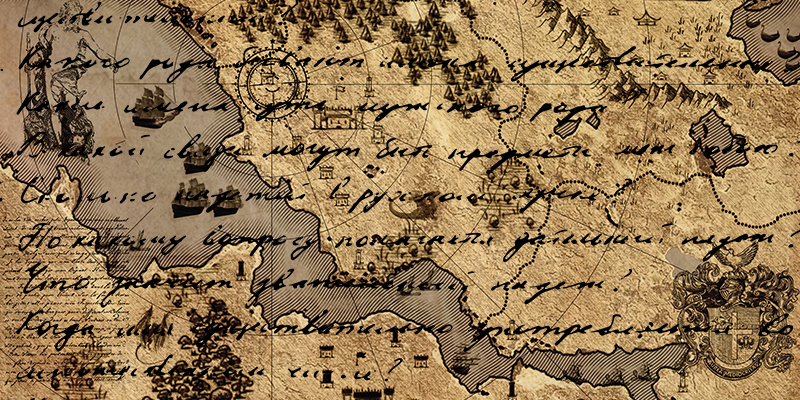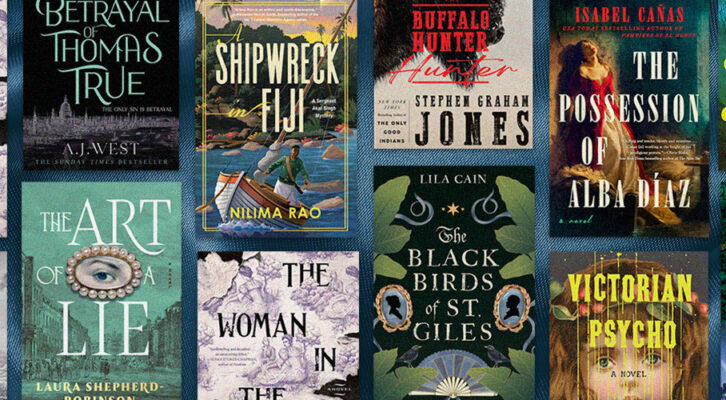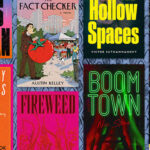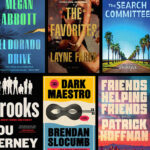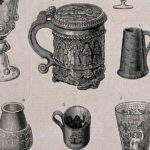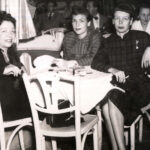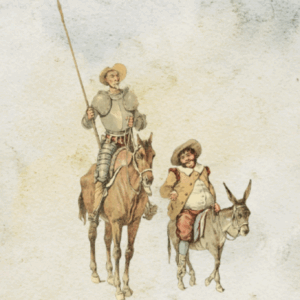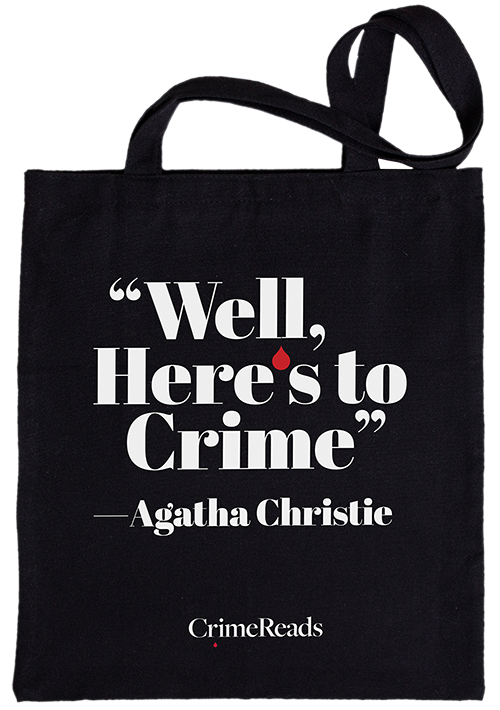The plot’s the thing, of course, in every good mystery. But mystery writers of the past century have found delicious ways to add layers—and fun—to our stories using features like cast lists, maps, epigraphs, and recipes. Chapter titles, glossaries, even footnotes.*
And why not? Our lives are multilayered. The asides in a conversation, the gestures, the literal and figurative illustrations all give our daily interactions richness and depth, and sometimes add to the mystery.
When you open the pages of a book, in print or on screen, the first thing you see may be an epigraph, an excerpt from another work that sets the tone or theme for the story you’re about to read. The connection may be obvious: You read the 1869 Frank Green poem that gives Agatha Christie’s 1934 classic And Then There Were None its title and instantly grasp the delightfully gruesome premise.
And when you reread “Good and Bad Children” from Robert Louis Stevenson’s A Child’s Garden of Verses in the front of The Child Garden by Catriona McPherson (2015), you get a flash of the horror and creepiness that underlie the haunting story ahead—and glimpse a bit of the Jekyll and Hyde in the poet himself. Who ever imagined a verse like that good bedtime reading for little ones?
The connection isn’t always so literal. My suspense novel, Bitterroot Lake (2021), written as Alicia Beckman), opens with a quote from Mary Oliver’s poem “The Journey” that sets a mood. The quote that opens Blind Faith (2022) is more philosophical, giving us one of the themes of the book: Our memories may comfort us, but they may also lead us into darkness. When a book opens with an epigraph—or a prologue—it’s always fascinating to turn back after finishing to see how it all ties together.
The chapter epigraphs in my Spice Shop Mysteries add to the fun, an essential element in a cozy mystery. My cozies are darker than some, never shying away from social issues and always “about something,” and I look for every opportunity to lighten the mood. Epigraphs are the ideal spot to sneak in tidbits from my research that could be too much of an info dump in the main text. In Lavender Lies Bleeding, the 9th Spice Shop mystery (out July 2025), you’ll learn that lavender is a member of the mint family, along with rosemary, thyme, and oregano. You’ll get harvest and cooking tips, historic uses, and linguistic origins, each just a line or three—an appetizer for the chapter ahead.
My setting, Seattle and the Pike Place Market, is ripe with history. Did you know it’s one of the oldest continuously-operating farmers’ markets in the country? The first business in the city licensed to a woman is in the Market, and still running. Naturally, it’s got ghosts, and epigraphs are the perfect place to tell their stories, briefly. Others relate tidbits of spice history, a key part of trade and warfare almost since time began.
Pepper Reece, my Mistress of Spice, is “a mature, introspective sleuth”** and some epigraphs reflect that. “Tastes and smells live on in our memories, like personalized time travel” is the perfect lead-in to the scene where Pepper explains how smells and memory are linked in the brain, leading to an indelible link in our lives. Others quote Brother Cadfael, the herbalist from the fabulous medieval mysteries by Ellis Peters and Pepper’s spirit guide, who comments on human nature and the difficulty of truth. An amateur detective’s approach, Peters wrote and I quote, “must rest mainly on the observation of character, which is of far more interest than forensic detail.” Those observations, like stories themselves, are built in layers.
Readers love Pepper’s sidekick, Arf, an Airedale with a mysterious past that comes to light in Lavender. Naturally, some chapters open with facts and quotes about dogs. Others relate to key imagery or locations, such as the old ramps in the Market, Seattle rain, or the century-old drawbridges that occasionally slow Pepper down—and give her a chance for “observation of character.”
Personally, I wouldn’t think it fair to hide a clue to the mystery in an epigraph, or in anything but the main text. Your mystery morals may vary.
Another useful layer is the cast list, again a throwback to the Golden Age. For me, the list is a way to introduce new readers to the main characters and to remind returning readers who will be keeping them company for the next few hours. Each list gets a title: “Inventory—Aka the Cast” (Assault & Pepper, 2015, the series opener), and “Sugar and Spice: Who’s Naughty and Who’s Nice?” (Peppermint Barked, 2022). Characters are grouped to clue readers into the connections: At Seattle Spice; The Flick Chicks; Market Merchants, Residents, and Friends; The Law. In The Diva Cooks a Goose (2010), Krista Davis introduces the families involved in the questionable festivities thematically: Merry Christmas from the Bauer Family, Christmas Greetings, Happy Holidays, Season’s Greetings.
Each character gets a brief description: Nate Seward—the fisherman. Lena Reece—Mom, a free spirit. Chuck Reece—Dad, still driving that ‘67 Mustang. That last is both a reminder for Lavender readers that Pepper’s parents are back in town and Dad wants his car back, and a hint that car trouble will be a part of the plot. (Writers, remember that the cast list is not a substitute for a good intro of each character. Not every reader will read or remember it. Play fair.)
Chapter titles aren’t often seen in the modern mystery, but Christie used them from the beginning, with The Mysterious Affair at Styles (1921). In the thirteen titles, first seen as a table of contents, Captain Hastings gives us a birds’-eye view of the story we are about to encounter, starting with “I Go to Styles,” and later, “The Night of the Tragedy” and “Fresh Suspects,” ending with “Poirot Explains.” In Murder on the Orient Express (1934), the chapters are titled and divided into three parts: The Facts, The Evidence, and Hercule Poirot Sits Back and Thinks.
Like the epigraphs and cast list, this structure gives the reader’s subconscious a whiff of anticipation. Her imagination begins to whirl and wonder, prepping her for the clues and clashes to come.
Readers love maps and drawings, although they’re not often seen in mass market paperbacks because the smaller format makes fitting a usable map on the page difficult. In my Bitterroot Lake, the graphic artist used my hand-drawn maps of Deer Park, Montana and the lakeshore property to create a map of the area with an inset for the key locations around Whitetail Lodge. The glorious illustrated maps in Deborah Crombie’s books help readers navigate unfamiliar locations—parts of London or a country village—and pullouts highlight images like a child dressed for his role in The Nutcracker, a bobby’s helmet, and a historic hotel or church. In The Mysterious Affair at Styles, the schematic of Mrs. Inglethorp’s bedroom shows the location of the doors, key to figuring out who could have been where when, and the kind of detail not always easy to work out through text alone.
Anyone who’s ever read a fat Russian novel or Victorian tale appreciates the family tree. They are useful in crime fiction, too. Christie’s After the Funeral opens with a simple family tree, showing the descendants of Cornelius and Coralie Abernathie and those present at a funeral, just the day before the murder that kicks off the story—and that may not have been the only murder.
Cozy mysteries like my Spice Shop and Food Lovers’ Village series often include recipes. I confess, if the recipes are simply a list of ingredients and instructions, I rarely give them a second glance. But when they’re woven into the story and continue the fiction, I’m hooked. The best recipes are themselves miniature stories of time, place, and taste. Some carry special meaning for the characters—and maybe for the authors. Recipes allow the reader to recreate fictional food at home. If the author gives her the opportunity to recreate the broader experience of the story, even better! So in Lavender Lies Bleeding, we don’t just have a recipe for Lavender Lemon Pepper Blend; we have a reminder that Cayenne was inspired to create the blend after seeing how creative cooks in Salmon Falls used their favorite local crop. My hope is that when the reader reaches the recipe section captioned “Spice up your life with Pepper and the Flick Chicks,” she’ll be right there in Laurel’s kitchen setting out the charcuterie, opening the box of lavender fudge, and remembering that that’s when Pepper showed her friends the photograph of Salter Farm. The stories they tell her reveal unexpected connections between people and places.
The recipe section can go beyond the story as well. Cleo Coyle’s Holiday Grind (2009), the 8th Coffeehouse Mystery, includes an extended section with coffeehouse terms, tips for being your own barista, and recipes for coffee drinks and holiday treats. But Coyle doesn’t just tell you how to make a Gingersnap Latte; she tells you which drink is Mike’s favorite and what he takes on an all-night stakeout. You’re still in story world, drinking in every drop and bite.
From the opening epigraph to the last recipe, a good mystery takes us places we’ve never been. A well-told tale tells us something new about the world around us and the people in it. And if it’s fun and helps us figure out what’s for dinner, even better.
* A tool I haven’t used yet, but who knows?
** Finally, a chance! Lesa Holstine, Lesa’s Book Critiques, on The Solace of Bay Leaves (2020)
***

